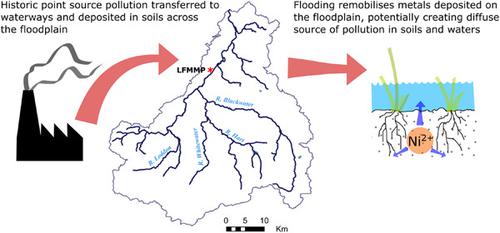当前位置:
X-MOL 学术
›
Environ. Toxicol. Chem.
›
论文详情
Our official English website, www.x-mol.net, welcomes your feedback! (Note: you will need to create a separate account there.)
The Effect of Flooding and Drainage Duration on the Release of Trace Elements from Floodplain Soils.
Environmental Toxicology and Chemistry ( IF 4.1 ) Pub Date : 2020-07-23 , DOI: 10.1002/etc.4830 Thomas J Kelly 1, 2, 3 , Elliott Hamilton 2 , Michael J Watts 2 , Jessica Ponting 1, 2 , Tom Sizmur 1
Environmental Toxicology and Chemistry ( IF 4.1 ) Pub Date : 2020-07-23 , DOI: 10.1002/etc.4830 Thomas J Kelly 1, 2, 3 , Elliott Hamilton 2 , Michael J Watts 2 , Jessica Ponting 1, 2 , Tom Sizmur 1
Affiliation

|
Floodplains downstream of urban catchments are sinks for potentially toxic trace elements. An intensification of the hydrological cycle and changing land use will result in floodplains becoming inundated for longer durations in the future. We collected intact soil cores from a floodplain meadow downstream of an urban catchment and subjected them to an inundation/drainage cycle in the laboratory to investigate the effect of flood duration on trace element concentrations in the soil porewater. The porewater concentrations of Ni, Cr, and Zn increased, whereas Cu and Pb decreased with flood duration. All the Cr present in porewaters was identified as Cr(III). Copper concentrations increased after drainage but Pb mobility remained suppressed. Both pH and dissolved organic carbon (DOC) increased with flood duration but were lower in treatments that were drained for the longest duration (which were also the treatments flooded for the shortest duration). The porewater concentrations of Cr and Ni decreased after drainage to levels below those observed before inundation, mirroring the DOC concentrations. We concluded that the duration of floodplain inundation does have an influence on the environmental fate of trace elements but that flooding does not influence all trace elements in the same way. The implications of an intensification of the hydrological cycle over the coming decades are that floodplains may become a source of some trace elements to aquatic and terrestrial ecosystems. Environ Toxicol Chem 2020;39:2124–2135. © 2020 The Authors. Environmental Toxicology and Chemistry published by Wiley Periodicals LLC on behalf of SETAC.
中文翻译:

洪水和排水持续时间对洪泛区土壤中微量元素释放的影响。
城市集水区下游的洪泛区是潜在有毒微量元素的汇。水文循环的加剧和土地用途的变化将导致洪泛区在未来更长的时间内被淹没。我们从城市集水区下游的洪泛平原草甸收集了完整的土壤核心,并在实验室中对其进行了淹没/排水循环,以研究洪水持续时间对土壤孔隙水中微量元素浓度的影响。镍,铬和锌的孔隙水浓度随着洪水持续时间的增加而增加。存在于孔隙水中的所有Cr被确定为Cr(III)。排水后铜浓度增加,但铅迁移率仍受抑制。pH和溶解有机碳(DOC)随洪水持续时间的增加而增加,但在排水时间最长的处理中也较低(这也是持续时间最短的处理)。排水后,Cr和Ni的孔隙水浓度降低至淹没前所观察到的浓度以下,这与DOC浓度相符。我们得出的结论是,漫滩泛滥的持续时间确实会影响微量元素的环境命运,但洪水不会以相同的方式影响所有微量元素。未来几十年水文循环加剧的影响是,洪泛区可能成为水生和陆地生态系统某些微量元素的来源。排水后,Cr和Ni的孔隙水浓度降低至淹没前所观察到的浓度以下,这与DOC浓度相符。我们得出的结论是,漫滩泛滥的持续时间确实会影响微量元素的环境命运,但洪水不会以相同的方式影响所有微量元素。未来几十年水文循环加剧的影响是,洪泛区可能成为水生和陆地生态系统某些微量元素的来源。排水后,Cr和Ni的孔隙水浓度降低至淹没前所观察到的浓度以下,这与DOC浓度相符。我们得出的结论是,漫滩泛滥的持续时间确实会影响微量元素的环境命运,但洪水不会以相同的方式影响所有微量元素。未来几十年水文循环加剧的影响是,洪泛区可能成为水生和陆地生态系统某些微量元素的来源。我们得出的结论是,漫滩泛滥的持续时间确实会影响微量元素的环境命运,但洪水不会以相同的方式影响所有微量元素。未来几十年水文循环加剧的影响是,洪泛区可能成为水生和陆地生态系统某些微量元素的来源。我们得出的结论是,漫滩泛滥的持续时间确实会影响微量元素的环境命运,但洪水不会以相同的方式影响所有微量元素。未来几十年水文循环加剧的影响是,洪泛区可能成为水生和陆地生态系统某些微量元素的来源。Environ Toxicol Chem 2020; 39:2124-2135。©2020作者。Wiley Periodicals LLC代表SETAC发布的《环境毒理学和化学》。
更新日期:2020-07-23
中文翻译:

洪水和排水持续时间对洪泛区土壤中微量元素释放的影响。
城市集水区下游的洪泛区是潜在有毒微量元素的汇。水文循环的加剧和土地用途的变化将导致洪泛区在未来更长的时间内被淹没。我们从城市集水区下游的洪泛平原草甸收集了完整的土壤核心,并在实验室中对其进行了淹没/排水循环,以研究洪水持续时间对土壤孔隙水中微量元素浓度的影响。镍,铬和锌的孔隙水浓度随着洪水持续时间的增加而增加。存在于孔隙水中的所有Cr被确定为Cr(III)。排水后铜浓度增加,但铅迁移率仍受抑制。pH和溶解有机碳(DOC)随洪水持续时间的增加而增加,但在排水时间最长的处理中也较低(这也是持续时间最短的处理)。排水后,Cr和Ni的孔隙水浓度降低至淹没前所观察到的浓度以下,这与DOC浓度相符。我们得出的结论是,漫滩泛滥的持续时间确实会影响微量元素的环境命运,但洪水不会以相同的方式影响所有微量元素。未来几十年水文循环加剧的影响是,洪泛区可能成为水生和陆地生态系统某些微量元素的来源。排水后,Cr和Ni的孔隙水浓度降低至淹没前所观察到的浓度以下,这与DOC浓度相符。我们得出的结论是,漫滩泛滥的持续时间确实会影响微量元素的环境命运,但洪水不会以相同的方式影响所有微量元素。未来几十年水文循环加剧的影响是,洪泛区可能成为水生和陆地生态系统某些微量元素的来源。排水后,Cr和Ni的孔隙水浓度降低至淹没前所观察到的浓度以下,这与DOC浓度相符。我们得出的结论是,漫滩泛滥的持续时间确实会影响微量元素的环境命运,但洪水不会以相同的方式影响所有微量元素。未来几十年水文循环加剧的影响是,洪泛区可能成为水生和陆地生态系统某些微量元素的来源。我们得出的结论是,漫滩泛滥的持续时间确实会影响微量元素的环境命运,但洪水不会以相同的方式影响所有微量元素。未来几十年水文循环加剧的影响是,洪泛区可能成为水生和陆地生态系统某些微量元素的来源。我们得出的结论是,漫滩泛滥的持续时间确实会影响微量元素的环境命运,但洪水不会以相同的方式影响所有微量元素。未来几十年水文循环加剧的影响是,洪泛区可能成为水生和陆地生态系统某些微量元素的来源。Environ Toxicol Chem 2020; 39:2124-2135。©2020作者。Wiley Periodicals LLC代表SETAC发布的《环境毒理学和化学》。


























 京公网安备 11010802027423号
京公网安备 11010802027423号